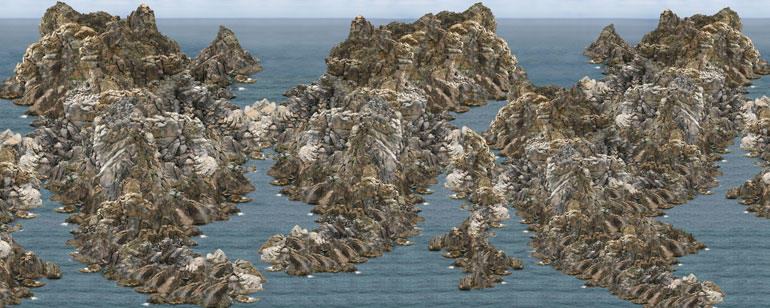
Jae Hoon Lee, Ha Jo Dae 2010, digitally collaged photography, 190 × 150 cm. Courtesy of the artist and Starkwhite, Auckland
The artists and their works
Ian Burns (b1964, Newcastle, Australia; resides New York City, USA) puts technology to wry and witty use, employing toy vehicles and cheap consumer objects to examine the speed of modern life and test our faith in moving images. In Burns’s bleakly comic Makin’ tracks 2010, a toy plastic Hummer literally rides roughshod over the entire globe, while 15 hours v4 2010 ingeniously dismantles the glamour of international air travel. Burns’ major piece in the exhibition is From orbit, a kind of clockwork universe or model space race that rises skyward in the Gallery’s entry vestibule. Combining repurposed technology and do-it-yourself special effects, From orbit evokes the ambition and absurdity of human attempts to journey beyond the planet Earth.
To get where they’re going, most travellers resort to cars, trains or planes. Charlie Sofo (b1983, Melbourne, Australia; resides Melbourne) prefers to walk, and see what reveals itself along the way. Fields is a record of his recent discoveries, a deck or low table filled with objects, sights and sounds gathered ‘out in the field’. The finds include a rock from the Gallery grounds, a slideshow of stones from the grooves of his shoes, a collection of paint samples lifted from suburban houses, and a video of Sofo touching familiar objects as if for the first – or last – time. Art, Sofo suggests, is less about adding new things to the world than looking afresh at what’s already there.
Jae Hoon Lee (b1973, Seoul, Korea; resides Auckland, NZ) makes travel photographs with a twist, harvesting hundreds of images in remote landscapes and combining them digitally. His two huge murals in Unguided tours are made from views Lee accumulated while walking in Korea and Nepal. Extending the results across entire walls, Lee updates the 19th-century tradition of wallpapering rooms with exotic landscapes. But he also evokes a contemporary sense of awe and unease in the face of nature. The repeated landforms suggest that a glitch or distortion is rippling through this place, at once extending and unsettling the journey. In a related video work, Lee uses surfaces photographed in India and Korea to create an endlessly rising stairway.
Arlo Mountford (b1978, Honiton, UK; resides Melbourne, Australia) makes ‘moving pictures’ – digital homages to famous historical paintings. In his new work The lament, he uses a virtual brush and palette to enter and animate one of the most famous imaginary landscapes ever made: French painter Watteau’s Pilgrimage to the Isle of Cythera 1717. For centuries, viewers have debated the mood and meaning of Watteau’s imaginary landscape. Are the couples setting out happily for the island of love, or sadly leaving it behind? Mountford keeps the question alive by presenting the 1717 painting beside Watteau’s second version of the work, presented in reverse. The two landscapes now form a new island, a double Cythera, which the animated figures traverse, circling endlessly between anticipation and nostalgia.
Gaming technology has been handled warily in the art world, but in their new work The outlands, David Haines (b1966, London, UK; resides Blue Mountains, Australia) and Joyce Hinterding (b1958, Melbourne, Australia; resides Blue Mountains, Australia) use a gaming toolkit called the Unreal Engine 3 to create ‘a journeying landscape’. Whereas commercial games often involve rapid-fire carnage and a frenetic pursuit of rewards, The outlands is a world where viewers are free to take their time and look around. Using customised control sticks, it’s possible to roam from fantastical spaces (a shimmering labyrinth) to hauntingly familiar ones (a coastal landscape that recalls southern New Zealand). But even if one is simply watching, ‘the outlands’ is open for imaginative exploration.
Unguided tours concludes with a journey that refuses to come to a conventional end. In her untitled film installation, Rachel Khedoori (b1964, Sydney, Australia; resides Los Angeles, USA) moves a camera through a local forest as if looking for something hidden. In a Hollywood film, this might be the viewpoint of a hunter looking for prey, or an explorer looking for exotic treasure. But no such reward appears. Instead the landscape itself becomes the source of the mystery, as it meets itself in a mirrored surface and appears to peel apart into suggestive new shapes. Instead of journeying towards a fixed destination, Khedoori presents us with an endless flow of projections and reflections – a mirror world that is at once familiar and strange, solid and fluid, densely detailed yet impossible to fully grasp.